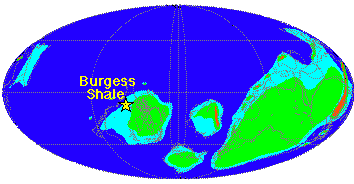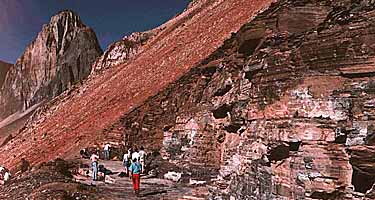
The Burgess Shale
Introduction and Discovery of the Burgess Shale
The Burgess Shale is found in an area of the Canadian Rocky Mountains known as
the Burgess Pass, and is located in British Columbia's Yoho National Park.
Part of the ancient landmass called Laurentia, centered in Hudson Bay,
the Burgess Shale represents one of the most diverse and well-preserved fossil
localities in the world. These fossils have been gathered from shales of
the Stephen Formation in two quarries opened
between Mount Wapta and Mount Field. The upper quarry is known as Walcott's
quarry and contains the most famous fossil-collecting site, the Phyllopod Bed.
The lower quarry is known as Raymond's quarry, named after Professor Piercy
Raymond of Harvard, a visitor of the site who opened the quarry in 1924.
It is now appreciated that the Burgess Shale is a site of exceptional fossil
preservation, and records a diversity of animals found nowhere else.
In 1981, to protect the site from overgathering, UNESCO designated the
Burgess Shale as a world heritage site.
The Burgess Shale contains the best record we have of Cambrian animal fossils.
The locality reveals the presence of creatures originating from the
Cambrian explosion, an evolutionary burst
of animal origins dating 545 to 525 million years ago. During this period, life
was restricted to the world's oceans. The land was barren, uninhabited, and
subject to erosion; these geologic conditions led to mudslides, where sediment
periodically rolled into the seas and buried marine organisms. At the Burgess
locality, sediment was deposited in a deep-water basin adjacent to an enormous
algal reef with a vertical escarpment several hundred meters high.
 |
The Cambrian World:
The map at left shows the Earth as it was in the Cambrian Period.
Green areas represent land above sea-level at that time, with red indicating
mountain ranges. Dark blue indicates deep ocean basins, while light blue
denotes shallow seas of the continental shelf. (For clarity, the outlines of
present-day continents have been added to the map.)
The location of the Burgess fauna is indicated by a star on the continent
of Laurentia (western North America). Notice that Canada is located just
south of the equator!
|
In 1909, the Burgess Shale was discovered by Charles D. Walcott of the
Smithsonian Institution. The legend has it that his horse stopped in front of
a rock which he then cracked open, discovering fossils. Walcott called the
Burgess Shale the "fossil-bearing unit", but it received little attention until
fifty years later. Finally in 1960, Alberot Simonella brought a renewed
interest to Walcott's work when he began to redefine members of the
Burgess Shale fauna. In 1967, the Cambridge project was intiated by
Harry Whittington. Two graduate students, Simon Conway Morris (a worm
specialist) and Derek Briggs (an expert in arthropods) joined him in this
endeavor. This trio of scientists became the leading authorities on the site.
Recent work has been continued by Desmond Collins, the curator of the
Canadian museum.
Through additional work on the site, it was determined that the Burgess Shale
included multiple fossil bearing layers of about 2 meters thick stacked
150 meters high and over 60,000 unique fossils have been found. The dominant
fossils found are arthropods,
but other fossils are found in great abundance, including worms, crinoids,
sea cucumbers, chordates, and other organisms with no mineralized shell.
Most fossils were found in underwater banks known as the phyllopod beds.
The Burgess fauna contains many fossils of soft bodied animals as well as
those with hard parts. This is a tremendous opportunity for researchers
because the soft bodied fossils are rarely found anywhere else -- such
organisms are usually destroyed before they can be preserved as fossils.
When an organism is completely soft, the body usually rots away before it
can become fossilized. Hard parts are important because they are more easily
preserved; they help the organism last long enough to become fossilized.
Walcott's Quarry : This is the site where Charles Walcott (pictured at
left) first discovered fossils of the Burgess Shale. In the distance, you can
see the peak of Mount Wapta. The slate and shale of the Stephen Formation are
the gray layers, and this is where most of the fossils have been found.
Taphonomy and Study of Burgess Fossils
The Burgess Shale has contributed significantly to the fossil record because of
the large number of well preserved fossils found within its layers. These
fossils exemplify a unique method of preservation. In most forms of
fossilization, the body of a dead organism settles to the bottom of a river
or lake whereupon sedimentation slowly covers the body. In the Burgess Shale
however, organisms lived in underwater mud banks known as phyllopod beds.
Water currents would periodically cause sediments to flow in
the form of mudslides, quickly burying the living organism in moving sediment.
Fossils are therefore found in random orientation, indicative of a violent
mudslide engulfing many of the Cambrian organisms. There is also evidence
that these organisms died instantly. First, in the presence of an anaerobic
environment, such as mud, marine invertebrates normally curl up upon dying.
Fossils of the Burgess Shale locality do not exhibit this coiling. Secondly,
there is no evidence of any attempt by these organisms to burrow out of their
mud "prison." Killed instantly by the mudslides, preservation began immediately.
The fossils of the Burgess Shale are spectacular, and many of them preserve
exoskeletons, limbs, and infillings of the gut. In some rare fossils there
is evidence of gut contents and muscle. For example, the internal organs are
especially well preserved in the fossilized Ottoia worms. However,
there are also many fossils that did not withstand geologic forces of the
past 500 million years. Many empty shells have been found because the soft
parts decayed and include Scenella and the brachiopods Lingulella
and Diraphora. In the case of
trilobites,
entire exoskeletons have been found without appendages. These trilobites
may have molted at the time of their death. The soft tissues of the appendages
may have decayed along with the highly perishable body contents, and only the
exoskeleton (shell) left behind became fossilized. Another arthropod,
Canadaspis, is found in clusters. These clusters have a mixture of
fossils exhibiting soft tissues and fossils exhibiting an absence of tissue.
The mudslides may have brought moltings and whole animals together, another
indication of the history of sediment flow in the Burgess Shale. The phyllopod
bed is therefore exceptional for possessing both typical fossil bearing
characteristics and unusual soft tissue preservation. This bed is highly
important because it records the first appearance of organisms with hard parts
in the fossil record.
Many fossils from the Shale exhibit a characteristic dark stain. This provides
evidence of the existence of soft bodied organisms during the Cambrian period.
After the death of these organisms, radioactive carbon in the soft tissues of
the organisms was converted into a film of mica and silicates, creating a
stain in the rock layer. Some fossils show this characteristic stain where
the soft parts would have been.
Walcott and later workers have used several different methods to excavate
these highly delicate fossils. First of all, erosion has accomplished part
of the uncovering, brining the fossil bearing layers to the surface. As stated
in Whittington (p.40), "erosion of the transported piles of rocks has produced
the mountains of today and exposed the shales on the ridge". The first and
most inefficient method used to remove specimens was to simply saw through
the slabs to get to the fossil, but this proved a poor method of recovery.
Preservation of the fossil in its entirety was difficult because the outline
of the remains was not known, and risk of sawing through the remains was high.
In addition, the crude saw caused fragmentation and disintegration of delicate
shales and fossils. Newer techniques have been used over time. Dissolving the
rocks in dilute acetic acid (vinegar) has retrieved fossils from
limestones. Another helpful excavation method uses UV light at a low
angle to show the overall shape, and at a high angle to highlight reflective
parts. This makes it easier for researchers to recognize and dig out the
fossils without breaking off parts.
Algae and unicellular fossils
Many unicellular organisms are also preserved here as microfossils.
A great many of these fossils are of uncertain systematic classification, not
recognizable as relatives of any particular living species. The microfossils
are spheres and may occur alone or in chains. This arrangement is also observed
in a great diversity of modern algae, and at least some of the fossils may
represent those organisms. Other unicellular organisms found include
bacteria, cyanobacteria, dinoflagellates, and other protists.
Macroscopic algae are common fossils in the Burgess Shale site. The most
commonly found species among them is Morania confluens. This species
is found in crowded fragments in the rock slabs. Oddly enough, there are
no other species of alga found fossilized in the same vicinity. There are also
very few animals found with this alga. Some of the rare animals found with
Morania include the polychaete worm Burgessoechaeta and rare
examples of Burgessa and Marella. Another alga found is
Marpolia spissa. This alga is a rarer find because of its delicate
branching, which is easily broken and disentegrated over time.
Maripolia has also been found in masses of broken fragments. The
animals found near this alga are Eldonia and Wiwaxia. Fragments
of both types of algae are preserved in thin, shiny carbon films.
By covering a specimen with transparent balsam, J. Walton was able to peel
these films off. Upon investigation through a microscope, individual branches
showed darker, longitudinal strips, while others had transverse dark bands.
Walton concluded that these strips and bands were evidence of cell structures.
An oddity regarding the two algae found is they are in almost complete
isolation of one another and from neighboring fauna. Perhaps the environment
supporting the algae prior to the mudslides was different from that of most
of the animals. In the vicinity of many fossilized animals, there is an
absence of these algae, indicative of a heterogeneous environment. Another
hypothesis involves the differential height in which the living algae were
found. Perhaps over time, portions of these algae were periodically broken
off and swept to a separate burial location in clumps.
Since its discovery in 1909, the Burgess Shale has become the authoritative
picture of life in the Cambrian Period. No longer solely relying on the
remnants of hard shells or exoskeletons, we now have a much better and richer
picture of early animal communities. The sediment flow fossilization of the
Burgess Shale has produced unique dark stained fossils that reveal the
countless variety of soft bodied organisms. Soft-bodied organisms are now
know to have existed in greater number and variety than those Cambrian
organisms exhibiting hard parts. Additionally, quarries of the Burgess Shale
contain evidence of the existence of our chordate ancestors, with fossils
so finely preserved that they display traces of a notochord. Most importantly,
the Burgess Shale tells of the Cambrian explosion, a huge radiation of marine
animal life that included sponges, soft bodied arthropods and those with hard
exoskeletons, the first chordates, worms, and trilobites, as well as the
strange spiked creatures such as Wiwaxia, and the large predator
Anomalocaris. The Burgess Shale represents a snapshot of the evolution
of a marine biota that would come to dominate the world's oceans for the
next 300 million years.
For more information about the Burgess Shale:
- The Yoho-Burgess Shale Foundation was founded to promote the geological sciences, especially where the
Burgess Shale is concerned. Their site has many fine photographs and a history of scientific study conducted.
- Strange Creatures is an exhibit on the Burgess Shale presented by the National Museum of Natural History (Smithsonian Institution). This
museum houses many of the first Burgess fossils found, including Walcott's collections.
- View many fine photos of the Fauna and Flora of the Burgess Shale, including rare pictures of fossil algae. The pages are part of a larger exhibit on the
Burgess Shale at the Hooper Virtual Paleontological Museum.
- Andrew MacRae has produced an exhibit on the Burgess Shale Fossils, a site hosted at the University of Calgary. This site is the source of many of the photos used in our exhibit, and more information about each photo may be found here.
- Visit Yoho National Park, the site of the Shale. Note that because the park is a World Heritage
Site, no collecting of any kind is allowed in the park and all visits to the shale must be guided. However, there are numerous fossils at the site, and a decent camera will allow you to bring back superb photos.

Photo of Charles Walcott courtesy the Hooper V.P.M. Images of the Burgess
locality and most fossils courtesy Andrew MacRae.
Map of the Cambrian world showing the location of the Burgess Shale modified from an existing map of unknown origin.
Sources:
- Briggs, D.E.G. 1991. Extraordinary fossils. American Scientist 79:130-141.
- Conway-Morris, S. 1986. The community structure of the Middle Cambrian Phyllopod Bed. Paleontology 29: 423-467.
- ----------. 1989. Burgess Shale faunas and the Cambrian Explosion. Science 246: 339-346.
- ----------. 1998. The Crucible of Creation: The Burgess Shale and the Rise of Animals. Oxford & N.Y.: Oxford University Press.
- Conway-Morris, S. & H. B. Whittington. 1979. Animals of the Burgess Shale. Scientific American 241: 122-133.
- ----------. 1985. Fossils of the Burgess Shale.
Goological Survey of Canada, Miscellaneous Reports 43: 1-31.
- Fletcher, T.P. & D. H. Collins. 1998. The Middle Cambrian Burgess Shale and its relationship to the Stephen Formation in the southern Canadian Rocky Mountains. Canadian Journal of Earth Sciences 35(4): 413-438.
- Gould, S. J. 1989. Wonderful Life: the Burgess Shale and the Nature of History. New York: Norton Press.
- Orr, P. J., D. E. G. Briggs, & S. L. Kearns. 1998. Cambrian Burgess Shale: Animals replicated in clay minerals. Science 281: 1173-1175.
- Piper, P. J. W. 1972. Sediments of the Middle Cambrian Burgess Shale Canada. Lethaia 5: 169-175.
- Sprinkle, J. & D. Collins. 1998. Revision of Echmatocrinus from the Middle Cambrian Burgess Shale of British Columbia. Lethaia 31(4): 269-282.
- Whittington, H. B. 1985. The Burgess Shale. New Haven: Yale University Press.








